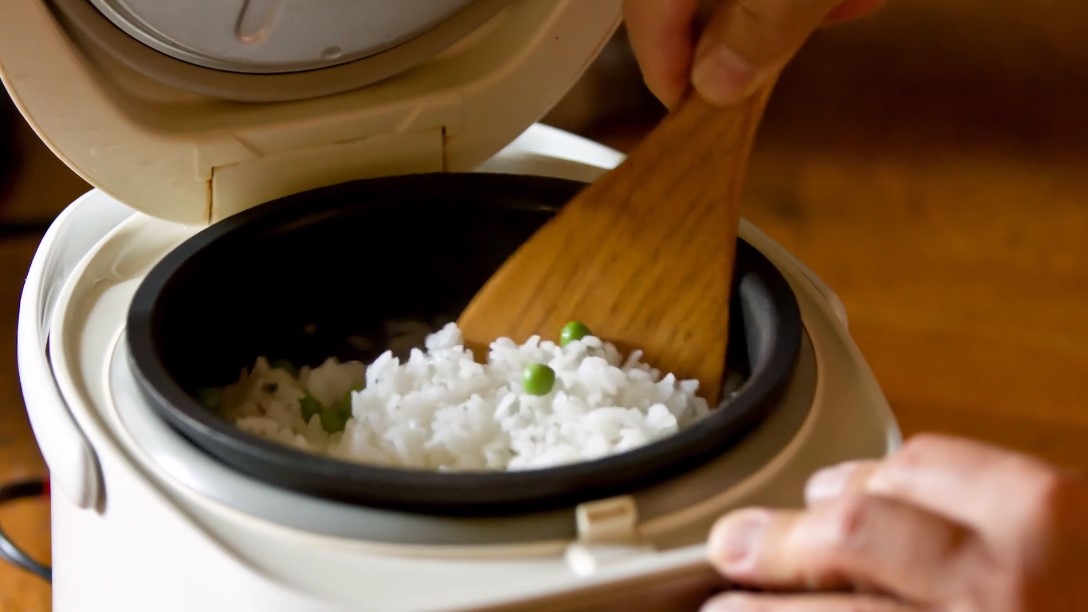Rice cookers have become increasingly popular in recent years, thanks to their convenience, versatility, and ability to produce perfectly cooked rice with minimal effort. These handy appliances have revolutionized how we cook rice, making it an effortless process that saves time and reduces the chances of burning or undercooking the grains. With numerous models and features available in the market, rice cookers cater to a diverse audience, from busy professionals to large families.
In this article, we delve into the age-old question: can you add butter and salt to a rice cooker? We’ll explore the benefits, risks, and tips for seasoning rice in a rice cooker, as well as examine other factors that affect the taste and quality of your rice.
Overview

The benefits of using a rice cooker extend beyond just convenience. They are designed to evenly cook by controlling the temperature and cooking time, leading to consistently fluffy, well-cooked grains. This precision is particularly valuable when cooking different types of rice, as each type requires specific temperature and time settings to achieve optimal results.
Additionally, they often have built-in features like keep-warm functions and programmable timers, ensuring that your rice stays at the ideal serving temperature even if you aren’t quite ready to eat. Furthermore, they are energy-efficient appliances, using less electricity than a stovetop and reducing the risk of boil-overs and scorched pots. Finally, they are versatile, allowing you to cook a variety of grains, steam vegetables, and even prepare one-pot meals.
Explanation of Why Some People Want to Add Butter and Salt to Rice
Adding butter and salt to rice enhances its flavor, texture, and aroma, transforming a plain side dish into a delectable treat. Butter imparts a rich, creamy taste and velvety texture, while salt helps to bring out the natural flavors. Additionally, seasoning it with butter and salt during the cooking process allows these ingredients to penetrate and flavor each grain, resulting in a more balanced and delicious taste.
For those with dietary restrictions, substituting butter with alternative fats like olive oil, ghee, or coconut oil can provide similar benefits. The desire to add butter and salt stems from the convenience of seasoning and cooking it simultaneously, saving time and reducing the number of dishes to clean.
When menu planning or considering dietary restrictions, it is important to take into account the overall balance of ingredients and portion sizes, ensuring that the addition of butter, salt, or alternative fats aligns with one’s specific dietary goals and requirements.
Potential Risks and Problems

Despite the appealing flavor benefits, there are some risks and potential problems associated with adding butter and salt directly to a cooker. First, butter has a lower smoke point than other cooking fats, which means it can burn at high temperatures, producing an unpleasant taste and potentially damaging the non-stick coating.
Moreover, adding salt can cause uneven cooking, as it can affect the boiling point of the water and interfere with the cooker’s temperature sensors. Furthermore, adding salt and butter directly to it might make it harder to clean, as the cooked-on residue can stick to the inner pot, requiring more effort to remove.
Analysis
After examining the potential risks and problems, it is safe to conclude that you can add butter and salt, but with some adjustments and considerations. The key is to ensure that you are using an appropriate amount of butter and salt and that you are monitoring the cooking process closely to prevent burning or uneven cooking.
Additionally, it is essential to follow the manufacturer’s instructions and guidelines, as some rice cookers may not be designed to handle the addition of fats and seasonings during the cooking process. By taking these precautions, you can safely enjoy the benefits of butter and salt in your rice without damaging your appliance or compromising the quality of your meal.
Different Types of Rice Cookers

There are several types on the market, each with its unique features and functions. The most common types include standard rice cookers, which simply cook it with an on/off switch; fuzzy logic, which use microcomputer technology to make precise adjustments to temperature and cooking time; and induction heat, which use an electromagnetic field to heat the entire inner pot for even cooking.
Understanding your specific features and functions is crucial when adding butter and salt, as different cookers may require different approaches to ensure a successful outcome.
Tips
To add butter and salt to it without causing damage or compromising the quality of your rice, follow these tips:
- Add the butter in small, evenly-distributed pieces to ensure even melting and flavor distribution.
- Use a moderate amount of salt to prevent interference with the rice cooker’s sensors and avoid over-seasoning.
- Stir rice, water, butter, and salt gently before starting the cooking process to encourage even cooking.
- Monitor it during the cooking process to ensure the temperature and cooking time remain appropriate.
- If possible, use it with a non-stick inner pot to minimize the risk of burnt or stuck-on residue.
Adjust the Cooking Time

When adding butter and salt, you may need to adjust the cooking time and settings to accommodate the additional ingredients. For fuzzy logic or induction heat ones, select a setting specifically designed for seasoned or flavored rice, if available. Alternatively, you can increase the cooking time by a few minutes to ensure it cooks evenly and absorbs the added flavors. Be sure to monitor it during the cooking process and adjust the time and settings as needed based on the rice’s appearance and texture.
Alternatives
If you prefer not to add butter and salt directly, you can still enjoy their flavors by seasoning it after cooking. To do this, simply cook it according to the manufacturer’s instructions, and then transfer it to a serving bowl. Add the desired amount of butter and salt, and gently fluff the rice with a fork to evenly distribute the seasonings. This method allows you to control the seasoning more precisely and eliminates the potential risks associated with adding butter and salt to the rice cooker.
Factors That Affect the Quality
Several factors can influence the quality and taste, including the type, the water-to-rice ratio, and the cooking method. Different types have unique flavors, textures, and cooking requirements, so it is essential to select the appropriate variety for your dish and adjust the water ratio and cooking time accordingly.
Generally, long-grain varieties require less water and have a more separated texture, while short-grain varieties need more water and yield a stickier texture. Following the manufacturer’s guidelines for your specific cooker and chosen variety will ensure a successful outcome.
Cleaning and Maintaining
Regular cleaning and maintenance are essential for the longevity and performance of your rice cooker. After each use, unplug the appliance and allow it to cool completely before cleaning. Remove the inner pot and wash it with warm, soapy water, using a soft sponge or cloth to remove any residue. Avoid using abrasive cleaners or scrubbing tools, as they can damage the non-stick coating.
Wipe the interior and exterior of the rice cooker with a damp cloth to remove any spills or splatters. Ensure all parts are thoroughly dry before reassembling and storing the appliance. To maintain optimal performance, periodically check the rice cooker’s heating element, temperature sensors, and other components for signs of wear or damage. Consult your rice cooker’s manual for specific maintenance recommendations and troubleshooting tips.
Common Mistakes
To achieve perfectly cooked rice in it, avoid these common mistakes:
- Using the incorrect water-to-rice ratio: Always follow the manufacturer’s guidelines for the appropriate water amount based on the type and quantity of rice.
- Skipping the rinsing step: Rinsing removes excess starch and prevents the grains from clumping together.
- Overfilling the rice cooker: Be mindful of your capacity and avoid overloading it to ensure even cooking and prevent boil-overs.
- Neglecting to stir the rice: Gently stirring before cooking encourages even heat distribution and prevents the grains from sticking together.
- Ignoring the keep-warm function: If it has a keep-warm function, use it to maintain the ideal serving temperature without overcooking.
FAQs

Can I use flavored salts or seasonings in my rice cooker?
Yes, flavored salts or seasonings can be used in it to add unique tastes and aromas. However, be cautious with the quantity, as overly strong flavors can overpower the grain.
Can I add liquid seasonings like soy sauce or broth to my rice cooker?
Yes, you can use liquid seasonings like soy sauce or broth to flavor your rice. Replace a portion of the water with the liquid seasoning, ensuring the total liquid-to-rice ratio remains appropriate for the type of rice being cooked.
Will adding butter and salt to my rice cooker void the warranty?
Adding butter and salt to your rice cooker should not void the warranty, as long as you follow the manufacturer’s guidelines and use the appliance correctly.
Can I cook rice in a rice cooker without any added water?
No, water is essential in a rice cooker. The water ratio and cooking time vary depending on the type being cooked, but water must always be included to achieve properly cooked grains.
How can I prevent my rice from sticking to the bottom of the rice cooker when adding butter and salt?
To prevent it from sticking to the bottom of the rice cooker when adding butter and salt, try these tips:
- Ensure even distribution of butter by adding small pieces throughout the rice.
- Gently stir it, with water, butter, and salt before starting the cooking process.
- Use the cooker with a non-stick inner pot to minimize the risk of sticking.
How do I know when my rice is done cooking in a rice cooker with added butter and salt?
When cooking it with added butter and salt, the cooker will typically switch to the “keep warm” mode or turn off automatically when it is done. However, always check the appearance and texture to ensure it is cooked to your desired level of doneness. The grains should be tender, fluffy, and evenly cooked, with the butter and salt fully absorbed. If necessary, adjust the cooking time or settings based on your observations.
Conclusion
In conclusion, it is possible to add butter and salt to a rice cooker, but doing so requires some adjustments and considerations to ensure a successful outcome. By understanding your rice cooker’s features and functions, using the appropriate amount of butter and salt, and monitoring the cooking process closely, you can enjoy the delicious flavors of seasoned rice without damaging your appliance or compromising the quality of your meal.
Alternatively, consider seasoning your rice after cooking to maintain precise control over the flavors and eliminate the potential risks associated with adding butter and salt to the rice cooker. With proper care, cleaning, and maintenance, your rice cooker can continue to provide perfectly cooked, flavorful rice for years to come.

